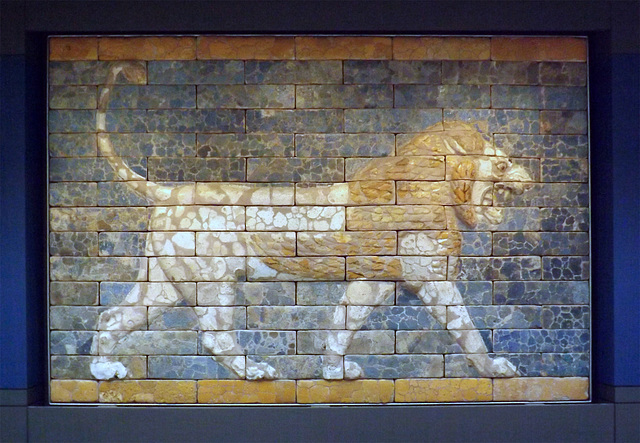See also...
Keywords
Authorizations, license
-
Visible by: Everyone -
All rights reserved
-
369 visits
Lion from Babylon in the British Museum, May 2014


The Department of the Middle East have been preparing to display a panel showing a pacing, roaring lion that was once was part of King Nebuchadnezzar II’s throne room in his palace in the ancient city of Babylon, Iraq. Alexandra Fletcher explains how the panel has been pieced together to be displayed for the very first time in London.
The panel shows a pacing, roaring lion and once was part of King Nebuchadnezzar II’s throne room in his palace in the ancient city of Babylon, Iraq. Nebuchadnezzar II reigned from 605-562 BC, and supposedly had the hanging gardens of Babylon built for his queen. Although there is little evidence to confirm his passion for gardening, it is certain that Nebuchadnezzar commissioned other major building projects in Babylon, to glorify the capital of his empire. Inscriptions stamped on bricks reveal the extent of these works. In the city of Babylon, glazed bricks in bright shades of blue, yellow and white were used to create public monuments that emphasised the power of the king and the gods. In Nebuchadnezzar’s throne room the roaring lions emphasized the power and might of the Babylonian king, whose empire stretched from the Persian Gulf to the Mediterranean and from the Caucasus to northern Arabia.
Finds excavated by Robert Koldewey at Babylon between 1902 and 1914 came to Berlin packed in crates. Staff spent years painstakingly joining fragments of glazed brick together to recreate Nebuchadnezzar’s Ishtar Gate and Processional Way, in Berlin. The panel loaned to the British Museum has been similarly pieced together from bricks the Vorderasiatisches Museum has in store and so is being seen complete for the very first time in London.
Text taken from: blog.britishmuseum.org/a-loan-from-berlin-a-lion-from-babylon
The panel shows a pacing, roaring lion and once was part of King Nebuchadnezzar II’s throne room in his palace in the ancient city of Babylon, Iraq. Nebuchadnezzar II reigned from 605-562 BC, and supposedly had the hanging gardens of Babylon built for his queen. Although there is little evidence to confirm his passion for gardening, it is certain that Nebuchadnezzar commissioned other major building projects in Babylon, to glorify the capital of his empire. Inscriptions stamped on bricks reveal the extent of these works. In the city of Babylon, glazed bricks in bright shades of blue, yellow and white were used to create public monuments that emphasised the power of the king and the gods. In Nebuchadnezzar’s throne room the roaring lions emphasized the power and might of the Babylonian king, whose empire stretched from the Persian Gulf to the Mediterranean and from the Caucasus to northern Arabia.
Finds excavated by Robert Koldewey at Babylon between 1902 and 1914 came to Berlin packed in crates. Staff spent years painstakingly joining fragments of glazed brick together to recreate Nebuchadnezzar’s Ishtar Gate and Processional Way, in Berlin. The panel loaned to the British Museum has been similarly pieced together from bricks the Vorderasiatisches Museum has in store and so is being seen complete for the very first time in London.
Text taken from: blog.britishmuseum.org/a-loan-from-berlin-a-lion-from-babylon
- Keyboard shortcuts:
Jump to top
RSS feed- Latest comments - Subscribe to the comment feeds of this photo
- ipernity © 2007-2025
- Help & Contact
|
Club news
|
About ipernity
|
History |
ipernity Club & Prices |
Guide of good conduct
Donate | Group guidelines | Privacy policy | Terms of use | Statutes | In memoria -
Facebook
Twitter











Sign-in to write a comment.